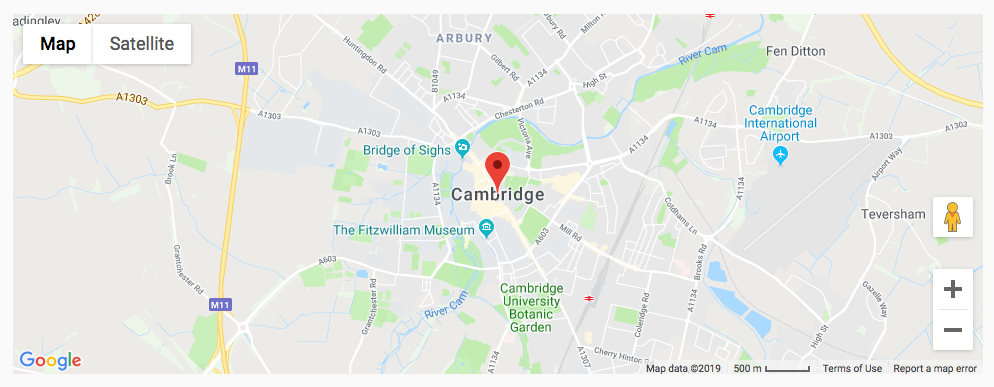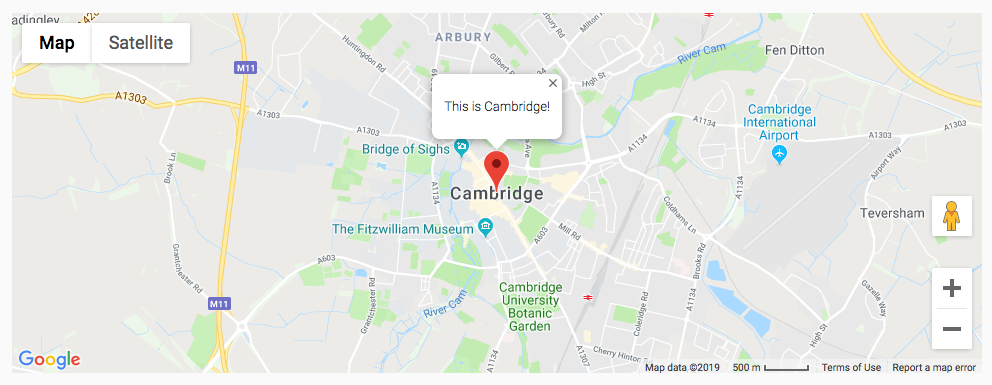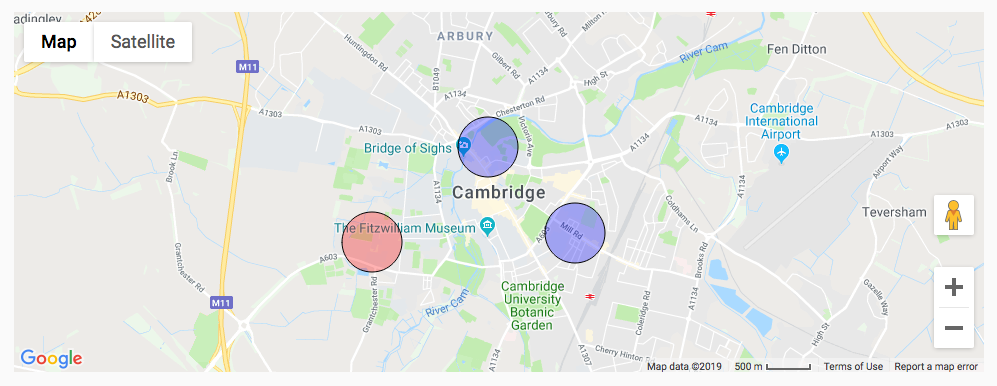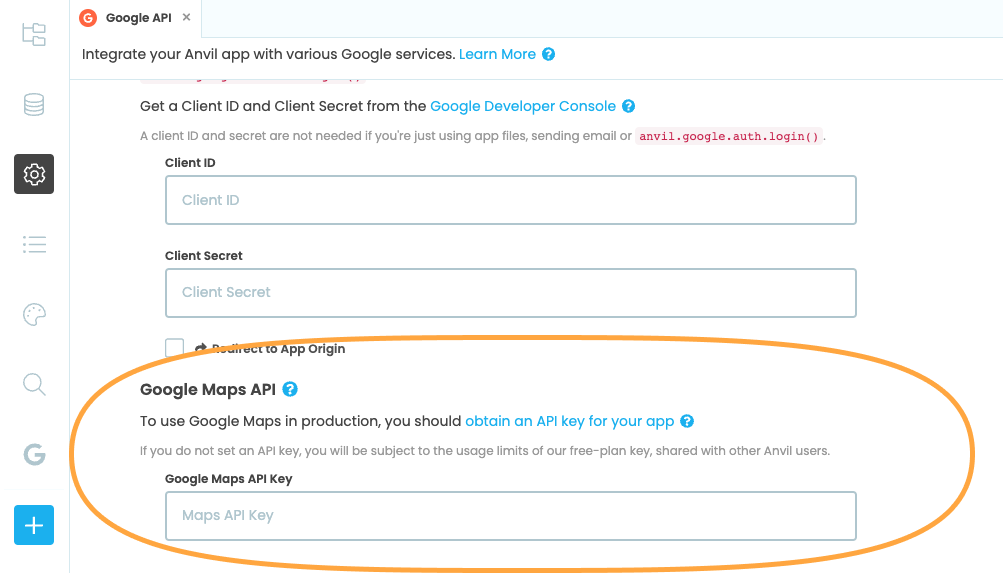Google Maps 
You can display interactive Google Maps on your Anvil Form with the GoogleMap component. Drag and drop onto your Form, or create one in code with the GoogleMap constructor.
map = GoogleMap()
map.center = GoogleMap.LatLng(52.2053, 0.1218)
map.zoom = 13
Markers and other overlays
GoogleMap components are containers. You can add various Map Overlay components to a map. In this example, we add a marker at a particular position and with a ‘drop’ animation.
marker = GoogleMap.Marker(
animation=GoogleMap.Animation.DROP,
position=GoogleMap.LatLng(52.2053, 0.1218)
)
map.add_component(marker)
Customising markers
You can customise Markers using their icon property. This can be set to a GoogleMap.Symbol or GoogleMap.Icon object:
-
GoogleMap.Symbolobjects are used to display particular shapes rather than icons. -
GoogleMap.Iconobjects are used to draw custom icons, which can be constructed with the URL of the image to display:
green_icon = GoogleMap.Icon(
url="http://maps.google.com/mapfiles/kml/paddle/grn-blank.png"
)
marker = GoogleMap.Marker(
animation=GoogleMap.Animation.DROP,
position=GoogleMap.LatLng(52.2053, 0.1218),
icon = green_icon
)
map.add_component(marker)
You can find all sorts of useful icon images here.
Overlays and mouse events
Markers (and other overlays) can respond to mouse events. In the code snippet below, we display an
InfoWindow anchored to the marker when the marker is clicked.
InfoWindows have a content property, which can be set to a string or an Anvil Component such as a Label or an entire Form - in this case we use a Label saying “This is Cambridge!”.
def marker_click(sender, **event_args):
i =GoogleMap.InfoWindow(content=Label(text="This is Cambridge!"))
i.open(map, sender)
marker.add_event_handler("click", marker_click)
Clicking on the marker brings up the message.
Drawing lines
To draw a line between positions on a map, add a GoogleMap.Polyline component to the map. In this example, we also add an arrow icon.
p = GoogleMap.Polyline(
path=[
GoogleMap.LatLng(52.215, 0.14),
GoogleMap.LatLng(52.195, 0.12),
GoogleMap.LatLng(52.21, 0.10),
],
stroke_color='blue',
stroke_weight=2,
icons=[
GoogleMap.IconSequence(
icon=GoogleMap.Symbol(
path=GoogleMap.SymbolPath.FORWARD_OPEN_ARROW,
scale=2
)
)
]
)
Complete list of overlay components
Here is a complete list of the available map overlay components, and their most important properties and methods. See the API Docs for complete lists of properties and events.
Each property is listed in the format property_name: argument_type
GoogleMap.Marker
Mark a particular point on the map. Draws a red pin by default.
Properties
-
animation:GoogleMap.Animation- Specifies the animation of this marker. Set toGoogleMap.Animation.DROP, orGoogleMap.Animation.BOUNCE. -
icon: can be either of the following:
GoogleMap.Symbol- Specifies the shape to display. If unset, a red pin is displayed.GoogleMap.Icon- Specifies a custom icon, constructed using theurlproperty.
-
label:GoogleMap.MarkerLabel | String- Describes the text label of this marker. -
position:GoogleMap.LatLng- Specifies the position of this marker.
Learn more about Markers in the Google Maps documentation
GoogleMap.InfoWindow
Display a popup on the map at a particular position.
Properties
position:GoogleMap.LatLng- Specifies the position of the popup. Not required if this popup is anchored to a component (see theopenmethod, below).content:anvil.Component | string- The content of the popup. Can be a string, or an Anvil Component.
Methods
open(map, [anchor])- Display this InfoWindow on the specified map. Ifanchoris specified, the InfoWindow does not need to have its ownpositionproperty set.close()- Hide this InfoWindow. The user can also cause this to happen by clicking the close button in the top-right of the popup.
Learn more about InfoWindows in the Google Maps documentation
GoogleMap.Polyline
Draw a line on the map.
Properties
icons:list of GoogleMap.IconSequence- Specifies the icons to display along this line.path:list of GoogleMap.LatLng- A list of points along the line.geodesic:boolean- Whether this line should follow the curvature of the Earth. DefaultFalse.
Learn more about Polylines in the Google Maps documentation
GoogleMap.Polygon
Draw a closed polygon on the map.
Properties
path:list of GoogleMap.LatLng- A list of vertices.geodesic:boolean- Whether the outline of this polygon should follow the curvature of the Earth. DefaultFalse.
Learn more about Polygons in the Google Maps documentation
GoogleMap.Rectangle
Draw a rectangle on the map.
Properties
bounds:GoogleMap.LatLngBounds- Specifies the position and size of this rectangle.
Learn more about Rectangles in the Google Maps documentation
GoogleMap.Circle
Draw a circle on the map.
Properties
center:GoogleMap.LatLng- The position of the circle.radius:number- The radius of the circle, in meters.
Learn more about Circles in the Google Maps documentation
In addition to the properties specified above, all overlays have clickable, draggable, and visible properties.
Overlays with outlines also have editable, stroke_color, stroke_weight and stroke_opacity properties.
Those with area have fill_color and fill_opacity properties.
See the official Google Maps documentation for more details.
Data visualisation
It is possible to use the Data Layer
to visualise location-based data instead of Overlays. In this example, we add point features to the map_data object, then set a rendering styles for all features at once.
map.map_data.add(GoogleMap.Data.Feature(
geometry=GoogleMap.Data.Point(
GoogleMap.LatLng(52.2,0.1))))
map.map_data.add(GoogleMap.Data.Feature(
geometry=GoogleMap.Data.Point(
GoogleMap.LatLng(52.21,0.12))))
map.map_data.add(GoogleMap.Data.Feature(
geometry=GoogleMap.Data.Point(
GoogleMap.LatLng(52.201,0.135))))
map.map_data.style = GoogleMap.Data.StyleOptions(
icon=GoogleMap.Symbol(
path=GoogleMap.SymbolPath.CIRCLE,
scale=30,
fill_color='red',
fill_opacity=0.3,
stroke_opacity=1,
stroke_weight=1
)
)
We could also generate feature styles dynamically by assigning a ‘styling function’ to the map_data.style property.
The function will be called once for every feature, and should return a corresponding style. In this example,
we choose the color of the circle based on the longitude of the feature.
def get_style(feature):
point = feature.geometry.get()
color = 'red' if point.lng() < 0.12 else 'blue'
return GoogleMap.Data.StyleOptions(
icon=GoogleMap.Symbol(
path=GoogleMap.SymbolPath.CIRCLE,
scale=30,
fill_color=color,
fill_opacity=0.3,
stroke_opacity=1,
stroke_weight=1
)
)
map.map_data.style = get_style
Making circles red or blue based on longitude.
Feature geometries
There are many tools available to define shapes on the map. In the example above, we were interested in points, so we
used GoogleMap.Data.Point. There are several others available, listed below.
See the official Google Maps documentation for more information.
GoogleMap.Data.Point(lat_lng)
Features are respresented by a particular position.
GoogleMap.Data.MultiPoint([lat_lng_1, lat_lng_2, ...])
Features are respresented by a set of positions.
GoogleMap.Data.LineString([lat_lng_1, lat_lng_2, ...])
Features are respresented by a line with specified vertices.
GoogleMap.Data.MultiLineString([line_string_1, line_string_2, ...])
Features are respresented by a multiple LineString geometries.
GoogleMap.Data.LinearRing([lat_lng_1, lat_lng_2, ...])
Features are respresented by a closed loop of vertices.
GoogleMap.Data.Polygon([linear_ring_1, linear_ring_2, ...])
Features are respresented by a set of closed loops. Additional loops denote ‘holes’ in the polygon.
GoogleMap.Data.MultiPolygon([polygon_1, polygon_2, ...])
Features are respresented by multiple polygons.
GoogleMap.Data.GeometryCollection([geometry_1, geometry_2, ...])
Features are respresented by an arbitrary set of geometries defined above.
Address lookup (geocoding)
You can look up addresses from locations, and vice-versa, using the GoogleMap.geocode function.
This function returns a GoogleMap.GeocoderResult array. In this example, we look up a location from an address, then display a marker.
results = GoogleMap.geocode(address="Cambridge, UK")
m = Marker(position=results[0].geometry.location)
map.add_component(m)In this example, we look up an address for a given lat/long.
results = GoogleMap.geocode(
location=GoogleMap.LatLng(52.2053, 0.1218)
)
print(results[0].formatted_address)There are several other properties available on the GoogleMap.GeocoderResult object.
See the official Google documentation for details.
If you want to do geocoding in Server Modules, you can use the geopy library (learn how to install it in your server environment here).
Here’s a simple server function that does a reverse geocode lookup using a free API:
from geopy.geocoders import ArcGIS
@anvil.server.callable
def geocode(lat, lng):
geolocator = ArcGIS()
location = geolocator.reverse((lat, lng))
print(location.address)Geocoding API quota
A shared Google Maps API key is provided to allow easy testing of your geocoding code. This is shared between all Anvil users for free, so the request quota may run out. This can cause your request to produce an error like this:
ExternalError: Geocode failed: REQUEST_DENIED
To use your own API key, obtain an API key for your app, add the Google API Service to your app, then enter your API key in the Maps API Key box:

Calculating length and area
The GoogleMap Component provides utilities for calculating length and area:
GoogleMap.compute_length([pos_1, pos_2, ...])
Returns the length of the line going through the specified points.
GoogleMap.compute_area([vertex_1, vertex_2, ...])
Returns the area of the polygon with the specified vertices.
# Calculate the length of the line.
GoogleMap.compute_length([
GoogleMap.LatLng(52.215, 0.14),
GoogleMap.LatLng(52.195, 0.12),
GoogleMap.LatLng(52.21, 0.10),
])
# Calculate the area of the polygon.
GoogleMap.compute_length([
GoogleMap.LatLng(52.215, 0.14),
GoogleMap.LatLng(52.195, 0.12),
GoogleMap.LatLng(52.21, 0.10),
])Google Maps in production
To use Google Maps in production with a custom domain, you should obtain an API key for your app.
To add this API key to your app, add the Google API Service, then expand the ‘Maps API Key’ section:

Do you still have questions?
Our Community Forum is full of helpful information and Anvil experts.
